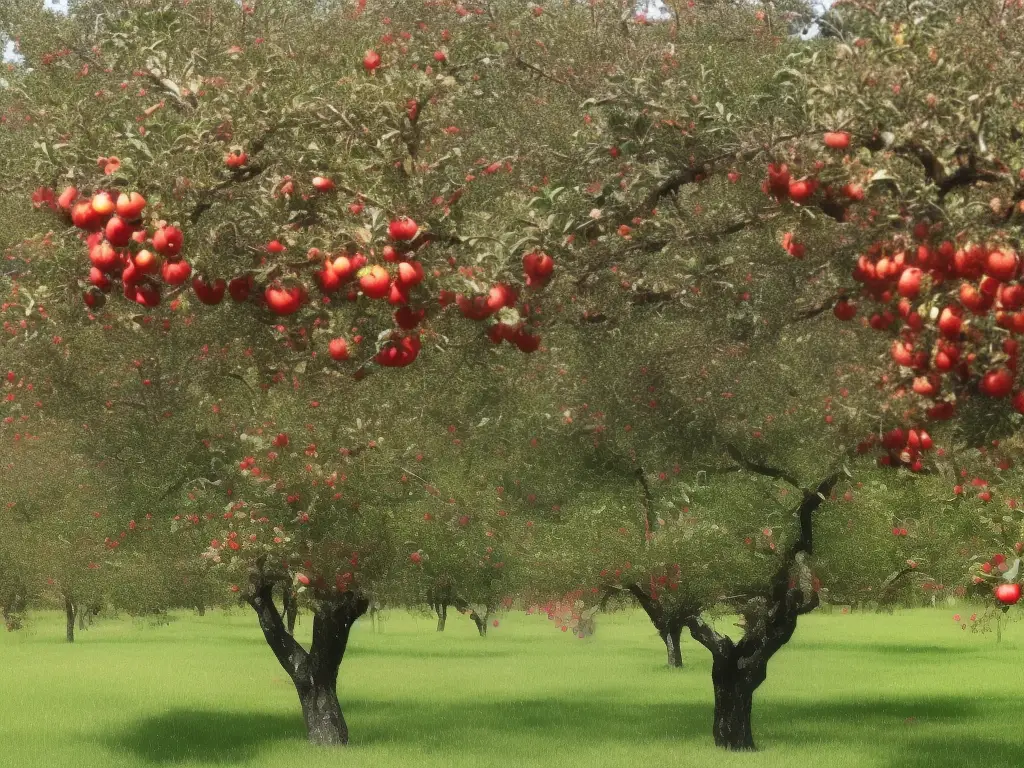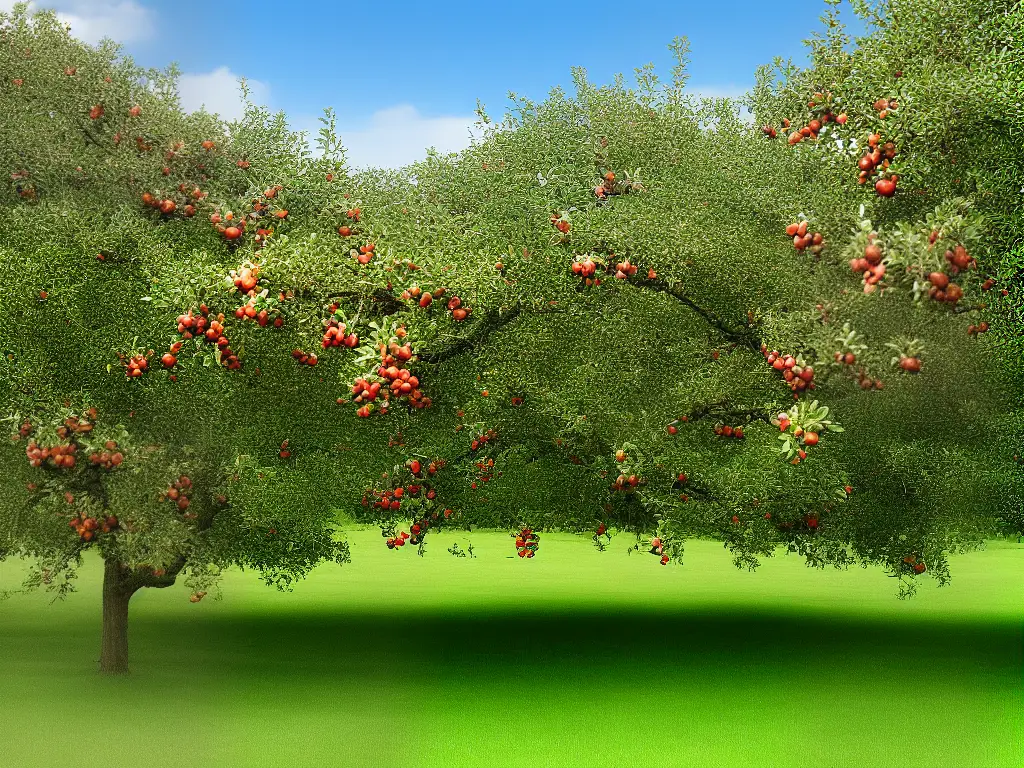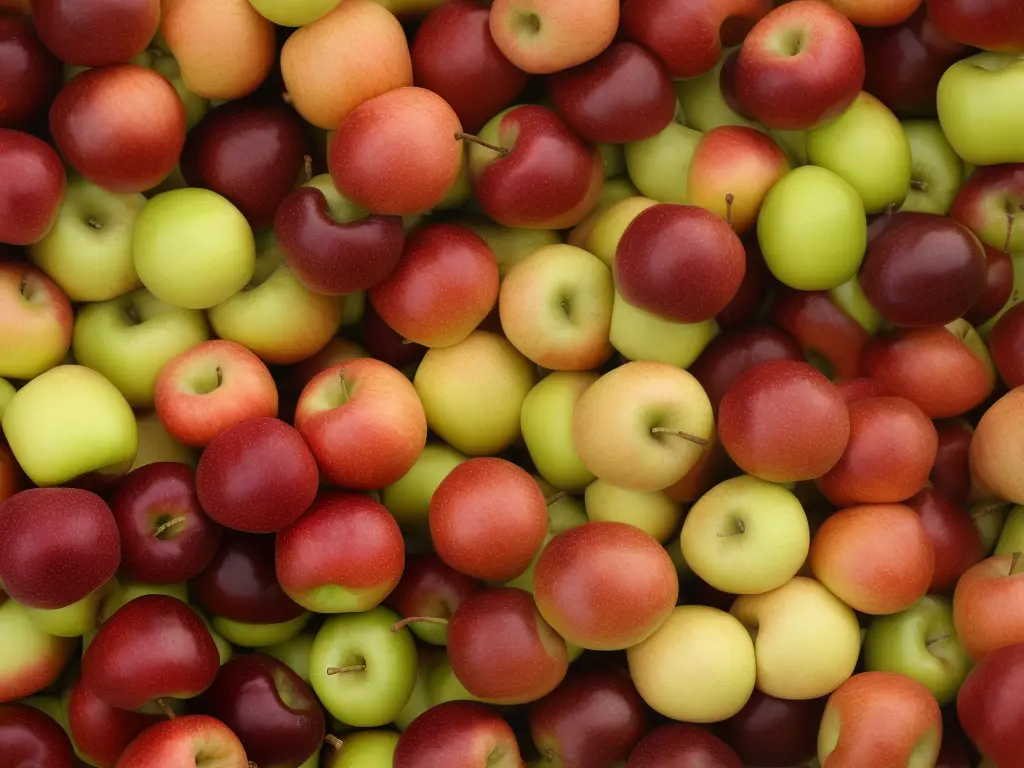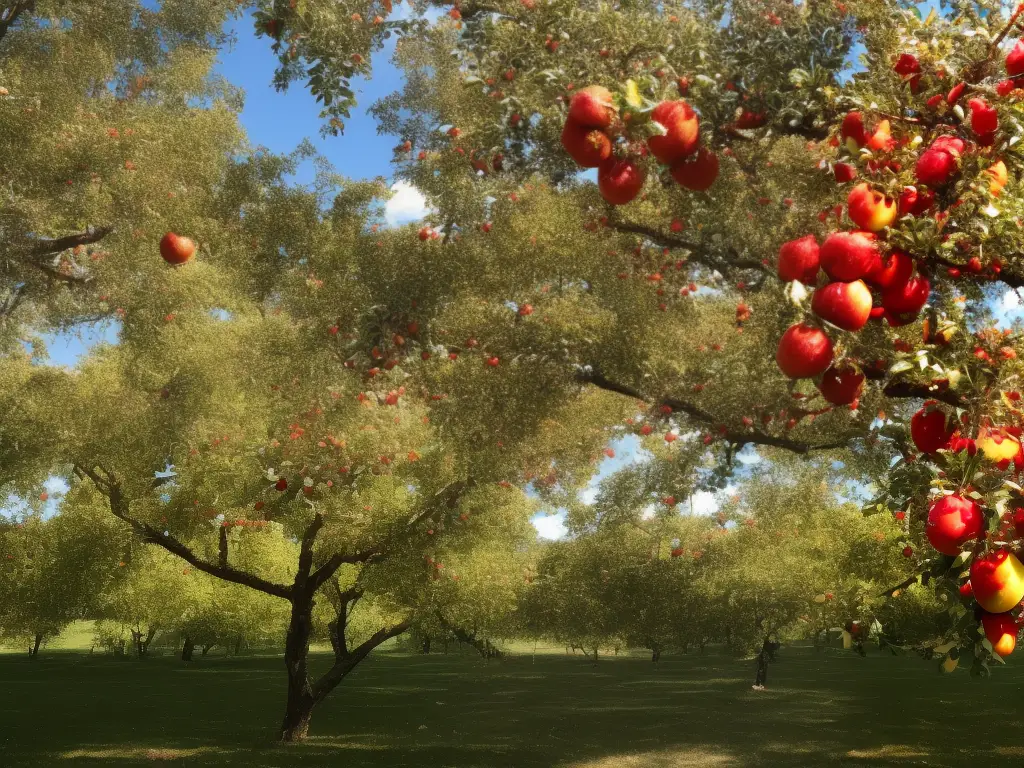There’s an undeniable charm that surrounds the Jonathan apple tree, a classic variety deeply rooted in American history. With its appealing combination of good looks and scrumptious flavor, it’s no wonder these trees have remained popular among apple enthusiasts for centuries. In our quest to become skilled at nurturing, preserving, and appreciating these magnificent trees and their delicious fruit, we’ll embark on an insightful journey that will deepen our understanding and appreciation for this iconic apple variety.
History & Origin
The Jonathan apple tree is a variety of apple cultivar that has been cherished by many since its discovery in the early 1800s. It is believed to have originated in Woodstock, New York, where it was first found growing by a man named Philip Rick. Rick, a local farmer, saw potential in this exceptional fruit and decided to propagate it. His decision to propagate the tree led to the widespread cultivation and eventual prevalence of the Jonathan apple tree in North America, and eventually in other parts of the world.
The genetic background of the Jonathan apple tree is a mix of European and American apple cultivars. Its parentage is said to involve the Esopus Spitzenburg apple, a classic 18th-century apple variety from the Hudson Valley region, and another unknown apple cultivar. This mix of genetic traits endows the Jonathan apple with a distinctive sweet and tart flavor that has made it a favorite among apple enthusiasts.
One of the most notable moments in the history of the Jonathan apple tree’s cultivation is its introduction to the Midwest region of the United States. In the mid-1800s, a group of settlers known as the “Iowa Orchard Company” sought out to establish fruit orchards in Iowa. They incorporated Jonathan apple trees in their efforts, and the success of their orchards showcased the tree’s adaptability to various climates and environments. Today, the Jonathan apple tree can be found growing in many different parts of the world, including North America, Europe, and even Australia.
Not only has the Jonathan apple tree earned a reputation for its versatile growing nature and unique flavor, but it has also played a significant role in apple breeding. The apple has been used as a parent to create other successful apple varieties, such as the Jonagold and the Jonamac. These offspring varieties have inherited the best qualities of their Jonathan apple parent – outstanding flavor and impressive adaptability – making them popular choices among apple growers and consumers alike.
In recent years, there has been a revival of interest in Jonathan apple trees, fueled by the growing demand for heirloom fruits and sustainable agriculture practices. Enthusiasts and hobbyists alike are rediscovering this classic variety and appreciating its unique characteristics that have stood the test of time. Indeed, it is the passion of individuals and communities that continue to uphold the legacy of the Jonathan apple tree and ensure its continued cultivation for future generations to enjoy.

Tree Characteristics
Popular among growers and garden enthusiasts, Jonathan apple trees are valued for their versatile nature and delicious, juicy apples. They exhibit a medium growth rate and typically reach a height of 12-15 feet, although some trees can grow as tall as 20 feet. To successfully cultivate a Jonathan apple tree, it’s essential to understand its growth habits and preferred environmental conditions, which will facilitate a fruitful and thriving tree.
An essential factor that plays a significant role in the growth and development of Jonathan apple trees is sunlight. These trees thrive best under full sun exposure, with a minimum of six hours of direct sunlight daily. Adequate sunlight is crucial for the tree’s photosynthesis process, which ultimately influences flower and fruit production. In addition to sunlight, Jonathan apple trees also require well-draining soil with a pH balance between 6.0 and 6.5. Slightly acidic, loamy soil is ideal for maximizing growth and fruit-bearing potential.
Water is another vital element for the healthy growth of Jonathan apple trees. Generally, these trees need around one inch of water per week, either from rainfall or supplemental watering. Drip irrigation systems are beneficial for maintaining consistent soil moisture and reducing water waste. It is essential to establish a balance with watering; overly saturated soil can lead to root rot and other health issues, while insufficient water can cause stunted growth or reduced fruit production.
Identifying a Jonathan apple tree can be done through a few of its distinct features. The leaves are medium-green in color and have an elongated oval shape with serrated edges, often curving slightly towards the central vein. The blossoms, which appear in spring, are white to light pink and have a pleasant fragrance. Once the fruit begins to develop, it is relatively small in size, round with a slightly elongated shape, and has a thin skin with a red blush over a green or yellow base.
One characteristic that makes Jonathan apple trees unique is their tendency towards biennial bearing, which means that they typically produce an abundant crop of apples every other year, with a lighter harvest in between. To minimize this effect and encourage more consistent production, it’s important to implement proper pruning, thinning, and fertilization techniques. By carefully managing the growing conditions of a Jonathan apple tree, you can look forward to an enjoyable harvest of sweet and slightly tart fruit, perfect for snacking, baking, and various culinary uses.

Cultivation
Successfully growing Jonathan apple trees begins with proper planting techniques that pave the way for healthy growth and fruitful yields. The ideal planting time usually falls between late winter and early spring, depending on the local climate. To start, dig a hole about twice the width of the tree’s root ball and just as deep as its roots. Make sure to loosen the soil at the bottom of the hole before placing the tree, ensuring that the graft union remains above the soil line. Then, fill the hole with a mixture of well-draining soil, compost, and any necessary soil amendments to provide an optimal environment for your Jonathan apple tree.
Pruning is essential for maintaining a healthy and productive Jonathan apple tree. Proper pruning techniques include removing any dead, diseased, or damaged limbs, as well as thinning out overcrowded branches to ensure adequate air circulation and sunlight penetration. Detailed pruning should begin when the tree is dormant, typically between December and February, and continue into the growing season as needed. Annual pruning helps manage the tree’s size and shape, promote strong growth, and encourage fruit production.
A healthy Jonathan apple tree also requires attention to soil conditions, as apples thrive best in well-drained, fertile soil with a pH of 6.0 to 6.5. The soil should be tested before planting, and necessary amendments should be added to balance the pH and improve drainage. Organic matter, such as compost or well-aged manure, can be added to improve soil fertility and structure. Regular soil testing and appropriate amendments throughout the tree’s life ensure the tree remains healthy and productive.
Jonathan apple trees should be planted in a location that receives full sun, ideally with six or more hours of direct sunlight per day. The planting site should also be sheltered from strong winds to protect the tree and prevent fruit drop. To promote healthy growth, young apple trees should be watered regularly during their first few growing seasons, with supplemental watering during times of drought. As the tree matures, it will become more drought-tolerant, but it will still benefit from consistent watering, especially during periods of fruit production.
As an enthusiast or hobbyist of Jonathan apple trees, it is essential to understand the importance of pest and disease control in maintaining healthy and productive trees. Implementing an integrated pest management (IPM) program, which combines cultural, biological, and chemical strategies, can help keep pests and diseases at bay. Practices such as promptly removing fallen leaves and fruit, using disease-resistant rootstock, monitoring the tree for signs of pests, and treating any issues as they arise will ensure a thriving Jonathan apple tree to enjoy for years to come.

Pest & Disease Management
Jonathan apple trees, like all fruit trees, are prone to various pests and diseases that can affect their overall health and fruit production. One common pest troubling these trees is the codling moth, the larvae of which burrow into the fruit, causing spoilage and reduced fruit quality. To combat the codling moth, gardeners can use pheromone traps and introduce beneficial insects like parasitic wasps (Trichogramma), which target moth eggs. Anticipating high moth activity, applying horticultural oils and insecticides containing spinosad can be effective.
Battling another common pest, the apple maggot, includes using yellow sticky traps and red sphere traps, which help monitor and decrease adult fly populations. For targeted control, insecticides such as spinosad, neem oil, and pyrethrin can be applied on trees, following the appropriate timing and application rates. Diseases like apple scab, presenting dark, velvety patches on leaves and superficial damage on fruit, can be managed through sanitation, pruning, and fungicides application.
Fire blight, a bacterial disease, appears as darkened shriveled leaves and spreads to branches as blackened, curled twigs. Treating fire blight involves pruning infected branches, sanitizing tools, and applying fixed copper products during early spring as a preventative measure. Ensuring proper tree health through adequate watering, regular fertilization, and appropriate pruning practices can bolster the tree’s defense against diseases while helping it recover from pest damage faster.
Propagation & Grafting
Propagation and grafting techniques are essential for cultivating and maintaining healthy Jonathan apple trees. Grafting, a common orchard management practice, allows for combining the positive traits of two apple varieties, ensuring their uniform growth. This process involves attaching a scion, or stem cutting from a desired apple variety (Jonathan apple, in this case), to a suitable rootstock known for its strong root system and disease resistance.
The ideal time to perform grafting is during the tree’s dormant season, typically from late winter to early spring, when the rootstock and scion are still dormant but close to their growth period. By applying these integrated pest management strategies and grafting techniques, Jonathan apple tree enthusiasts can ensure thriving tree health and enjoy abundant apple harvests.
There are several grafting techniques available for Jonathan apple trees, but whip and tongue grafting and T-budding are the most common. The whip and tongue method is usually employed during the dormant season, while T-budding is best done in late spring or summer when the rootstock’s bark easily separates from the wood. These methods require skill and attention to detail, as the success of the graft depends on a close match between the scion’s cambium layer (where plant growth occurs) and the rootstock’s cambium. When properly aligned, these cambium layers fuse together, promoting new growth and providing the plant with nutrients and support.
Another critical factor related to the propagation of Jonathan apple trees is the choice of rootstock. Rootstocks can have a profound impact on the tree’s growth, fruit production, and overall health. For instance, dwarfing rootstocks reduce the tree’s size, making it more manageable for harvesting and pruning. However, this reduced size may also lead to decreased root anchoring and overall vigor. There are various rootstocks available, each with its distinct set of characteristics, so it’s essential to choose one that complements the desired traits of the Jonathan apple tree.
Moreover, rootstocks can often impart disease and pest resistance to the grafted tree, further enhancing the Jonathan apple’s durability. For example, some rootstocks provide natural resistance to diseases like fire blight, a bacterium that can severely hinder apple production. It’s paramount to research the common diseases and pests that affect apple trees in a specific region and ensure selecting a rootstock that offers resistance to such threats.
If you’re an enthusiast or hobbyist wanting to master the art of grafting and propagation techniques for Jonathan apple trees, it’s essential to seek guidance from experienced growers or educational resources. Participating in workshops or engaging with local extension offices can provide valuable insights. Learning to graft demands practice and patience, but once mastered, it can significantly enhance the health and productivity of a Jonathan apple tree, making the investment of time and effort worthwhile.
Harvesting & Storage
When it comes to enjoying the delightful taste and firm texture of Jonathan apples, timely harvesting is crucial. Ripening times may vary according to climate and growing conditions, but generally fall between late September and early October. Look for a deep, rich red color with a slightly yellow background, indicating that the apples are ripe and ready to pick. Another sign of ripeness is the ease at which the apples detach from the tree when gently twisted – a ripe apple will release with minimal resistance, signaling that it’s time for harvest.
When it comes to picking Jonathan apples, your technique can make all the difference in preserving their quality. It’s crucial to handle the fruit delicately to avoid bruising and damage. To properly harvest the fruit, grasp the apple gently yet firmly, pushing it upward and giving it a slight twist. This should cause the apple to separate from the tree easily. Be sure to avoid pulling or tugging on the apple, as this could damage the fruit or the tree.
Once the apples are harvested, proper storage is key to prolonging their enjoyment. Jonathan apples have a relatively short shelf life compared to other apple varieties, lasting only a few weeks when stored at room temperature. However, their shelf life can be extended to several months if stored in colder conditions. Ideally, they should be stored in a dark, cool place, like a cellar or refrigerator, with the temperature maintained at 30-32°F with high humidity.
Attention should also be paid to how the apples are stored within the chosen environment. Storing them in groups or stacking them on shelves are both effective methods. When using containers, apples should be placed in a single layer with enough space between each fruit to minimize contact and reduce the risk of bruising. If you notice any apples with visible signs of damage or rot, remove them from storage immediately to prevent the spread of decay to the other apples.
In conclusion, understanding the harvesting and storage process is crucial for fully appreciating the taste of Jonathan apples. By learning the signs of ripeness, employing the correct picking techniques, and implementing reliable storage methods, enthusiasts can enjoy the flavor of freshly harvested Jonathan apples for an extended period.
Apple Uses & Recipes
Furthermore, Jonathan apples are a versatile fruit with a unique sweet-tart flavor, making them suitable for a variety of culinary applications. As hobbyists become skilled in managing Jonathan apple trees, they can further explore the endless possibilities of incorporating these delicious apples into their dishes.
Baked Goods
One popular use for these apples is in baked goods, such as pies, tarts, and cobblers. The firm flesh of the Jonathan apple holds up well when cooked, allowing it to maintain its shape and texture in baked recipes. Additionally, the pleasant balance of sweetness and tartness adds a depth of flavor when combined with spices such as cinnamon, nutmeg, and allspice.
Applesauce and Apple Butter
Aside from their use in baked goods, Jonathan apples are also well suited for making applesauce and apple butter. When cooked down, their natural sweetness and acidity lend themselves to creating a delicious and flavorful sauce or a rich, velvety apple butter. These products can be enjoyed on their own, as a topping for yogurt or oatmeal or used as a base for savory recipes such as apple-glazed pork chops or roast chicken with apple and onion.
Fresh Applications
Jonathan apples can also be used in fresh applications, such as salads and slaws. Their crisp texture and tart flavor make them a perfect addition to dishes where a pop of brightness is desired. Combining thinly sliced Jonathan apples with a tangy vinaigrette, leafy greens, and flavorful cheese can elevate a simple salad into a delightful, restaurant-quality dish. Similarly, adding diced apples to a coleslaw mixture can add an unexpected touch of sweetness that balances the tanginess of the dressing.
Non-Culinary Applications
Apart from their culinary uses, Jonathan apples have also found their way into non-edible applications. Some people utilize the apples’ natural acidity as a mild cleaning agent capable of removing stains and tarnish from various surfaces, such as copper pots and pans. Additionally, the slices of apple can be used as a natural potpourri when placed in a bowl, releasing a pleasant and inviting fragrance throughout a living space.
Incorporating Jonathan apples into your daily life can be as simple as enjoying them as a fresh, healthy snack or experimenting with new recipes to showcase their versatility. From the culinary world to just simply finding new ways to enjoy this delicious fruit, Jonathan apples offer a wide range of possibilities. Regardless of whether you’re an experienced chef or merely looking for new ways to appreciate this tasty variety, it’s always a good time to explore the opportunities Jonathan apples have to offer.

Community Involvement
To develop your skills and knowledge of Jonathan apple trees further, become involved with your local community of fellow apple enthusiasts, growers, and associations. By connecting with others who share your passion for this unique variety of apples, you can exchange valuable information, ideas, and personal experiences about the cultivation and care of Jonathan apple trees. Not only will this help you build a strong foundation of understanding regarding the trees themselves, but it will also create numerous opportunities to collaborate with fellow apple-lovers who possess a wealth of experience and expertise in this field.
Another effective way to immerse yourself in the world of Jonathan apple trees is to attend various workshops, events, and meetings that are designed to educate and inform individuals such as yourself about the intricate details surrounding this special variety of apple. Often, these events will cover topics like planting, pruning, and pest control specific to Jonathan apple trees, which can prove invaluable in your quest to become a skilled grower. Additionally, these gatherings also serve as an excellent platform for networking with other individuals in your community who share your interests and are eager to provide support and resources to help one another thrive.
Engaging with local apple growers and associations may also introduce you to various volunteer opportunities or internships that provide hands-on experiences for those looking to learn more about Jonathan apple trees directly. Participating in such opportunities can provide you with invaluable real-world experience in caring for and maintaining these trees. This practical knowledge will inevitably complement the theoretical information you acquire through workshops and events, culminating in an impressive skill set and comprehensive understanding of Jonathan apple trees.
Furthermore, connecting with local apple growers can provide you with the added benefit of receiving personalized advice and mentorship specific to your region’s unique growing conditions. As local growers are likely to possess specific expertise in cultivating Jonathan apple trees in your area’s climate, striking a relationship with these individuals can undoubtedly accelerate your understanding and growth as a knowledgeable enthusiast.
Lastly, establishing relationships within the local apple-growing community can be a mutually beneficial arrangement, whereby you can share your own experiences and learnings with others, further enriching the collective knowledge base surrounding Jonathan apple trees. By actively participating in this community and contributing your unique insights, you can become both a skilled grower and a valuable resource for others looking to deepen their own understanding of this fascinating variety of apple trees.

As our exploration of the Jonathan apple tree draws to a close, we’re left with a newfound appreciation for its rich history and the intricate art of nurturing and harvesting this beloved fruit. With a wealth of knowledge and a passion for preserving its legacy, we can proudly take our place within the wider community of enthusiasts and experts. By continually learning from one another, cultivating relationships, and embarking on hands-on experiences, we ensure that future generations can enjoy the delightful charms of the Jonathan apple and revel in the joys of cultivating their own orchards.